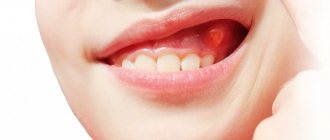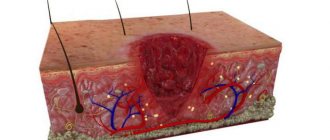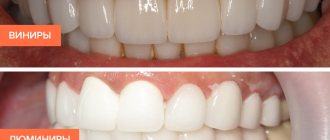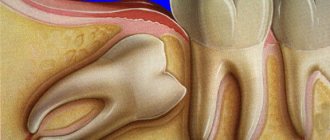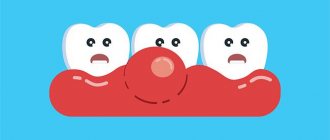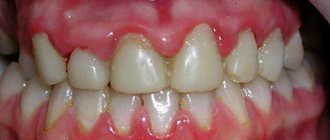Seal
Swelling of the gums, of varying severity, is a common problem. It can either be accompanied by unpleasant or painful sensations or occur without pain. But even in cases where the swelling does not cause discomfort, the process should not be left to chance. In the vast majority of cases, the tumor indicates inflammation occurring in the tissues of the gum or tooth.
Kabanova Natalya Aleksandrovna – dentist-therapist at the Dentoclass clinic.
Causes of edema
Swelling of the gums is a consequence of penetration of pathogenic bacteria into the soft tissues, causing infection.
Provoking factors:
- tartar formed due to poor oral hygiene;
- advanced form of caries;
- untreated stomatitis;
- infectious diseases of the throat;
- mechanical damage to soft tissues;
- difficult teething;
- immunodeficiency;
- vitamin deficiency (mostly severe lack of vitamin C);
- herpes virus activity;
- allergies to dental drugs or materials;
- development of purulent processes inside the tooth;
- the presence of tumors on the tooth root;
- gum diseases.
Before making a diagnosis, the dentist will definitely prescribe diagnostics to determine the internal state of the tissues, which will more clearly define the clinical picture and identify the main cause of the pathology.
Eliminating symptoms with folk remedies
If you do not have the opportunity to see a specialist, but inflammation of the gums and cheeks still bothers you, you can fight this phenomenon with folk remedies. The most effective measures will be:
- Rinse with a solution of salt and soda after each meal (also before bed). To prepare the medicine, add half a spoonful of salt and half a spoonful of soda to a glass of boiled water.
- Rinse with an infusion of 3 calendula flowers in 0.75 liters of boiling water. An alternative to this remedy can be a decoction of St. John's wort, prepared in the following proportions: 2 tablespoons of raw material per glass of water. The product should sit for 2 hours.
- Rinse your mouth with a decoction of chamomile and sage (given in equal quantities) after each meal, as well as in the morning and evening.
- If the inflammation is local, it is recommended to cover the affected area with propolis. This remedy will quickly relieve swelling.
- A mixture of calamus, sage, oak and nettle can also get rid of swelling. To prepare it, you need to add 10 grams of each dried plant to the decoction and let the mixture brew for about 2 hours.
Associated symptoms
Often gum swelling is accompanied by other symptoms:
- swelling of the cheek;
- fistula formation;
- tooth pain;
- bleeding gums;
- sensation of a metallic bite;
- redness of the gums;
- discharge of pus from the carious cavity;
- loosening of the crown;
- the appearance of ulcers;
- increase in general body temperature;
- the appearance of white plaque on the gums.
If there are signs of a purulent process, then contacting a dentist should be done immediately. Complications can lead to serious consequences not only for the oral cavity, but also for the entire body.
Content:
- Etiology: why gums swell 1.1. Non-inflammatory causes
- The gums are swollen and very painful: the main reasons
- What to do if the gum is swollen after removal 3.1. The most problematic teeth
- Symptoms that require immediate medical attention
- Preventing swelling in the mouth
The most common reasons that force you to seek help from a dentist are toothache and discomfort associated with the condition of the soft tissues of the periodontium.
For example, if the gums are swollen, swelling of the cheek mucosa and even facial asymmetry are observed. Inflammation indicates that it is the cause of the pain, so a visit to the clinic is indispensable. When the gums are swollen, only the dentist will understand what to do first, since this condition occurs in several forms and occurs due to various reasons. By eliminating their influence, it will be possible to relieve inflammation, pain, bleeding, bad breath, strengthen teeth and prevent the development of serious consequences.
Possible dental diseases
In 90% of cases, swelling of the soft tissues around the tooth appears with the development of periodontitis, gingivitis, periodontitis or an abscess. Other possible causes are extremely rare.
Periodontitis
With the development of periodontitis, the inflammatory process affects the bone tissue of the jaw. The cause of the pathology is the penetration of infection of the dental root canals and its spread. Swelling of soft tissues during periodontitis is caused by the accumulation of pus. If left untreated, pus may be released through the resulting fistula. The swelling subsides during this period, but the inflammation cannot be eliminated on its own. Treatment is mandatory.
Gingivitis
A distinctive feature of gingivitis from periodontitis is the development of an infectious and inflammatory process in the soft tissues surrounding the tooth. Swelling of the gums with gingivitis mainly occurs during the period of exacerbation. The swelling of the gums can be so severe that the tissue covers the tooth.
Periodontitis
The development of periodontitis occurs against the background of advanced periodontitis. Lack of treatment provokes a purulent process with a localized abscess area. With a periodontal abscess, a cavity forms under the gum in which pus accumulates. Externally, in addition to edema, a pronounced swelling in the form of a semicircle up to 1–2 cm in size appears on the soft tissue. Treatment is carried out surgically.
Prevention
Advice! After completing the filling, it is necessary to reduce the occlusal load on the tooth to the maximum. The diet should include food of soft and medium consistency, preferably homogeneous in composition (yogurt, kefir, porridge) and during the period of getting used to the filling you should chew on the opposite side.
Eating soft foods can help reduce the chewing load after filling.
With your doctor's permission, you can take analgesics to relieve pain for 3-4 days. However, if measures to prevent the appearance of pain in the gums after filling in the tooth canals are not effective, then it is recommended to consult a doctor. Although the overall cost of treatment may increase, it is more important to prevent complications.
If, after placing the filling, you begin to experience constant pain in the gums, you should urgently go to the doctor. The development of the inflammatory process in the absence of intervention goes further and this can lead to a number of serious complications, in the form of odontogenic cysts and osteomyelitis.
Treatment methods
Depending on the cause of gum swelling and accompanying pathological processes, the doctor may prescribe conservative treatment, or resort to surgical manipulation or tooth extraction. The clinical picture is determined by the results of examination and radiography.
Conservative therapy
When visiting a dental clinic, a specialist eliminates the cause of gum swelling and then begins to eliminate inflammation, symptoms and associated pathological processes.
The patient may be prescribed drug therapy, including:
- antiviral;
- painkillers;
- antibiotics;
- antihistamines.
Local therapy that has an antiseptic effect is required. The dentist may recommend the use of special ointments or gels, rinsing the mouth with medications or herbal decoctions.
Surgery
The help of surgical dentistry is necessary for certain indications. The need for surgical intervention arises with the development of a purulent process. The specialist will need to open the gum, fistula or root canal to release the pathological fluid. Next, the affected cavity is cleaned, treated with an antiseptic, and treatment of the underlying disease begins. Swelling of the gums can be a sign of a serious pathology that requires tooth extraction. The need for extraction or the possibility of saving the tooth is assessed by the doctor.
What to do if the gum is swollen after removal
Extraction of a dental unit is a fairly serious intervention, after which swelling and pain persist for up to 3 days. At this time, it is important not to overdo it with rinsing so that a blood clot forms in the socket. It not only stops bleeding, but also protects the wound from the penetration of pathogenic bacteria, and also starts the process of regeneration, that is, healing.
If swelling of the cheek begins during rehabilitation, dentists recommend applying cold compresses to it. Under no circumstances should you rinse your mouth forcefully, touch the hole with your tongue, make suction movements, drink or eat something hot, spicy, or sour.
If the swelling does not decrease in due time, and the hole itself acquires a grayish tint, an ichorous odor, and pain appear, you should visit the doctor again. Perhaps alveolitis has begun.
The most problematic teeth
The most complications are caused by the removal of the “eights”, because they are often located atypically, and a more complex operation is required. The more extensive the intervention, the longer the recovery takes. But if there is a choice between preserving a tooth or extracting it (according to indications), then it is better to get rid of it.
Third molars are of no value - they are not involved in chewing, they are difficult to clean and treat. Often there is not even enough space for them in the dentition, so the figure eight crown partially remains under the gingival hood. Food gets clogged under this formation, plaque accumulates there, so there is a possibility of pericoronitis.
Due to the particular placement of wisdom teeth, any problems with them are complicated by collateral edema, which limits mouth opening and makes chewing difficult. In order to assess the need for intervention and the condition of the tooth and alveolar process, it is necessary to conduct an x-ray examination.
The gums hurt where there was no tooth
Pain can also appear in places where there has never been a tooth. The reasons for this are more specific:
- The child is teething (first teeth or permanent teeth growing in place of lost milk teeth). In both cases, the pain will go away on its own and surgery is not required. You can relieve pain by rinsing with decoctions of medicinal herbs.
- Wisdom teeth are coming through. It may be necessary to cut the gum and extract the tooth, as the process is often very painful and lengthy.
Wisdom tooth eruption
How to get rid of pain at home
If you suddenly begin to experience pain in a place where a tooth is no longer present, it is not recommended to apply warm compresses, wrap the area of inflammation with a warm cloth, or take warm decoctions. Due to heating, suppuration most often occurs, which causes unpleasant consequences.
Cooling the inflamed area helps relieve pain. In this case, you can use ice compresses or just a cool cloth.
A cold compress will help relieve pain and swelling
Folk recipes help relieve inflammation of the flesh at the site of an extracted or dead tooth: a decoction of chamomile, oak bark. You should not intensively rinse the sore spot, as there is a chance to wash out the newly formed blood clot. It's better to just keep the decoction in your mouth for a while.
No folk remedies will help with advanced inflammatory process. Self-medication makes sense only in the initial stages of the disease.
Pain at the site of a dead tooth
It happens that the nerve has been removed from the teeth, but they still hurt. If the nerve is not completely removed or the doctor put too much filling material into the canal, then the pain will not leave you for a very long time and will occur when eating hard, cold or hot foods.
Pain in a dead tooth can appear due to the fact that tissue inflammation has gone too far, and not only the nerve and pulp are affected, but also the bone tissue that surrounded the tooth, as well as due to the use of too aggressive drugs in treating the nerve.
Often, to regenerate tissue at the site of the inflamed nerve, a course of special anti-inflammatory drugs is prescribed. To avoid problems with inflammation when extracting the nerve, it is recommended to first install a temporary filling.



